There are so many misconceptions, myths, and half-truths surrounding my Native people. Below you’ll find a compelling collection of Native American facts I gathered to share with your students. Some may challenge your preconceptions, others may pique your curiosity, and many more have the power to inspire a profound sense of wonder and respect.
These Native American facts were gathered from various sources with attentiveness and thorough consideration. But it’s crucial to remember that these insights only scratch the surface of the expansive, multifaceted realities of these Indigenous people. The true essence of Native American ceremonies, traditions, and ways of life often lies beyond the confines of textbooks and academic archives, passed down through the power of oral storytelling and firsthand accounts. It’s always best practice to seek the truth directly from the people themselves. If you seek a deeper understanding and connection to who we are and the history of this land, ask us about our story and you will see.
Plus, click the button below to receive your own Google Slides to share these facts easily with your classroom.
Intriguing Native American Facts
1. There are 574 federally recognized tribes in the United States.

This means these tribes are officially recognized by the government and can receive special programs and services. They also have certain rights, like making some of their own laws and decisions.
2. The giant sequoia tree is named after the Cherokee chief Sequoyah, who invented the phonetic written alphabet for the Cherokee language.

In 1847, Austrian scientist Stephen Endlicher named the coastal redwood trees Sequoia sempervirens. He was likely honoring Cherokee chief Sequoya, who created an alphabet with 86 symbols for the Cherokee language. Later, in 1854, a French scientist named Joseph Decaisne used the same name for giant sequoias, which are related to the coastal redwoods.
3. Many U.S. state names come from languages of Native American tribes.

For example, Texas comes from the Caddo word taysha (translated to tejas in Spanish), meaning “friends” or “allies,” which highlights the friendly relationships among the Native tribes. Similarly, Michigan is named after the Ojibwe word mishigama, meaning “large water” or “large lake,” referring to its location near the Great Lakes.
4. Before the colonization of North America, there were as many as 500 native languages spoken on this continent.

Many native languages have disappeared, but some are still spoken today. When the last speaker of a language dies, the language is lost forever. However, Native communities are working to preserve and revive their languages, with some tribes successfully bringing back lost languages using old books and articles.
5. Nike designed a shoe specifically for the unique build of Native American feet.

Nike’s research for creating the specialized shoes included more than 70 tribes. That shoe is the N7 and was released in 2007.
6. The Lakota, Dakota, and Nakota tribes all revere the buffalo as a sacred animal.

The three tribes once used every part of the buffalo, from the hair for rope to the teeth for jewelry and the bones for tools, weapons, and toys. Nothing was wasted.
7. Birchbark canoes were light and durable modes of transportation for Native peoples residing near large bodies of water.
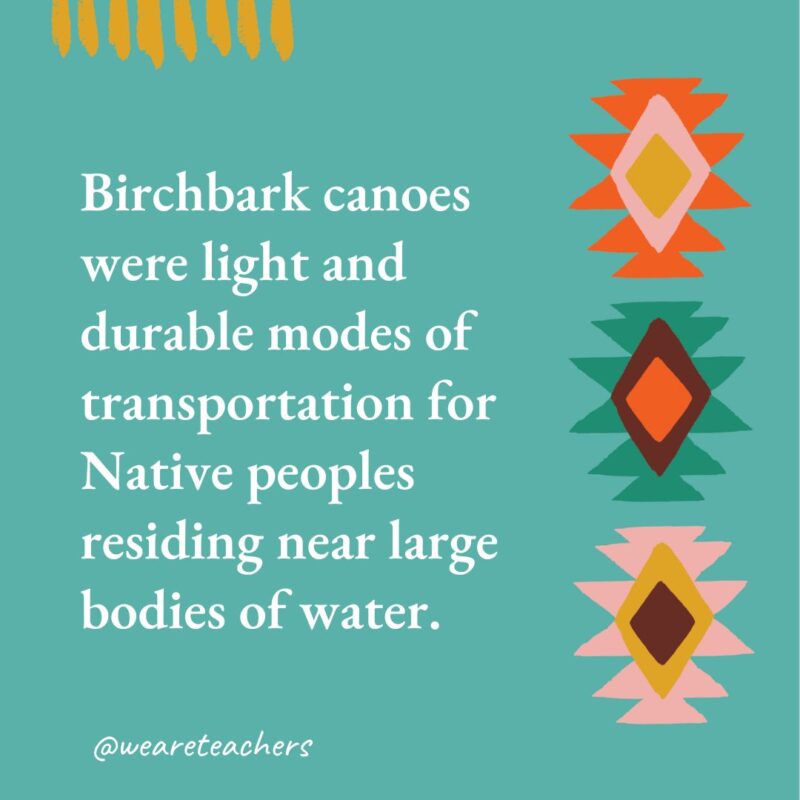
To preserve their canoes for another season, the Ojibwe people would line the canoe with clay and stones and sink it to the bottom of the lake. After the winter ice melted, they would retrieve the canoe and use it for another year.
8. “Counting coup” on your enemy is the highest honor in battle.

Killing another warrior was not as honorable as counting coup on them. Counting coup is achieved when a warrior can touch an enemy with a stick, war club, or whip without being harmed. In this manner, the warrior who counts the coup is showing the other that his life could have been taken, but he is spared on this day. This show of dominance and skill was the highest honor one could earn in battle.
Setting Native American Facts Straight
9. Pocahontas did not marry John Smith, nor was she a princess.
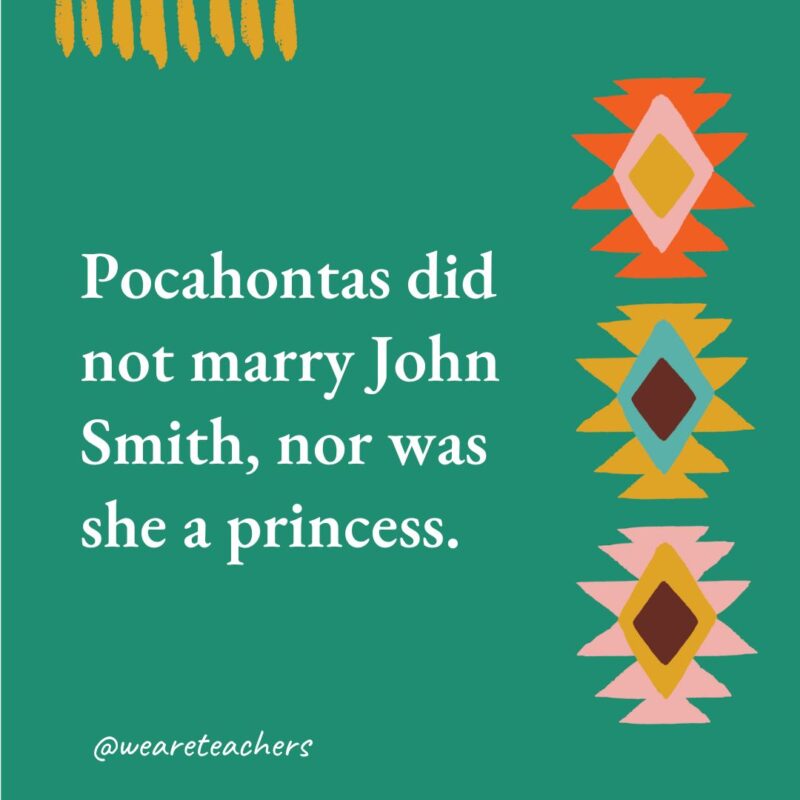
Remember, movies are for entertainment, not historical facts. She was married to John Rolfe.
10. Native Americans don’t use the term “shaman” in their culture. They use the phrase “medicine man.”
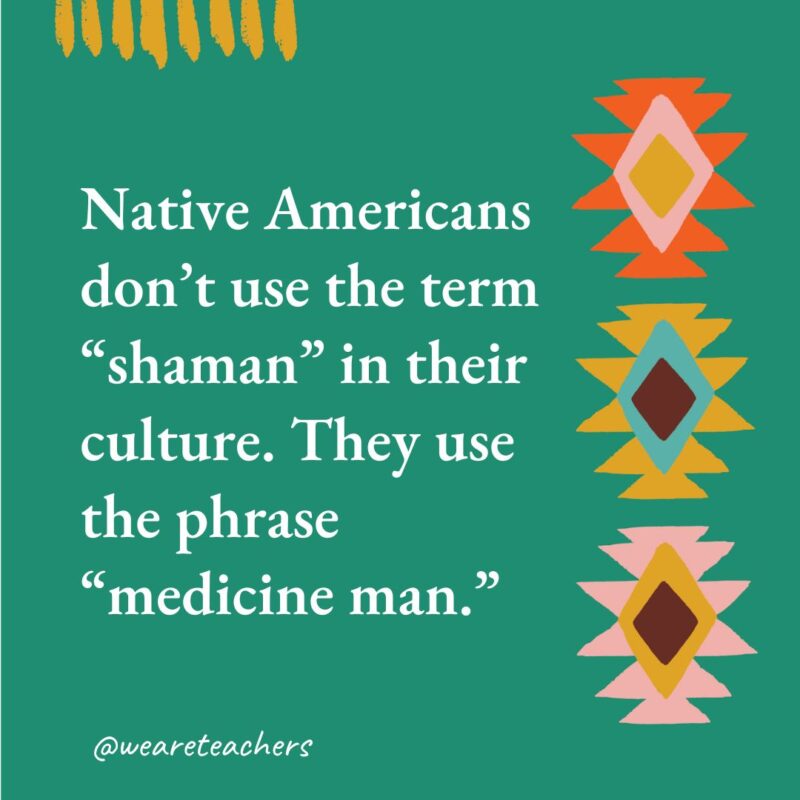
In fact, many Native Americans find the term “shaman” offensive. The word “shaman” actually comes from Siberia, where it describes a holy person who interacts with deities and spirits through direct contact, prayer, rituals, and offerings.
11. Witchcraft, skinwalkers, and Bigfoot/Sasquatch are all very real beliefs in Native American culture.
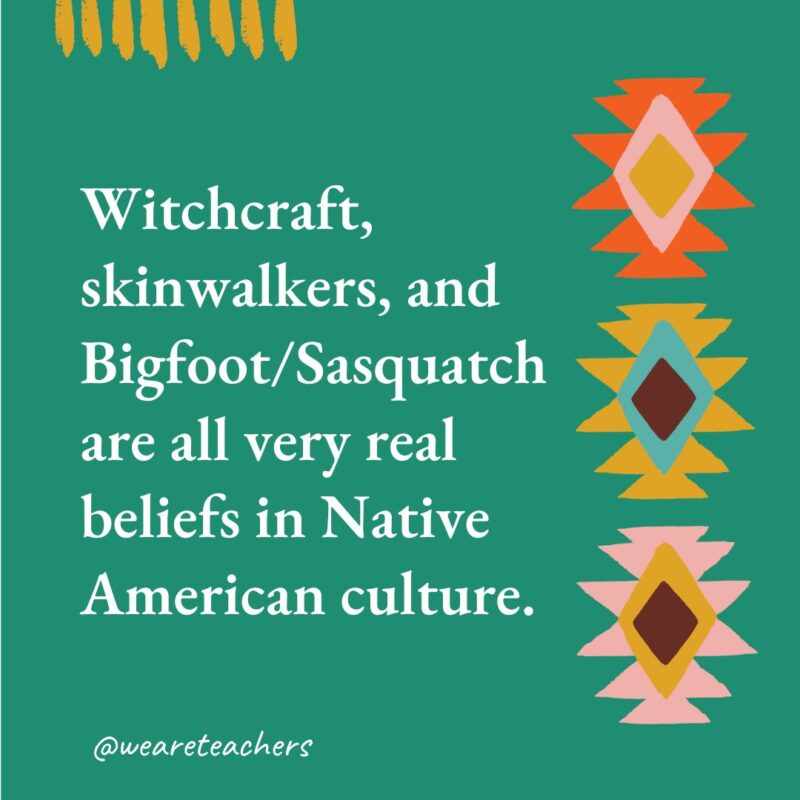
For example, the Navajo believe in skinwalkers—shape-shifters who can take the form of animals. Becoming a skinwalker involves violent rituals, and those initiated are considered “pure evil.” These legends are deeply rooted in Native American culture and are as real to them as any other myths are to other cultures.
12. A war bonnet (feathered headdress) is not a costume or decoration, it is an honor reserved for the greatest of Native people.
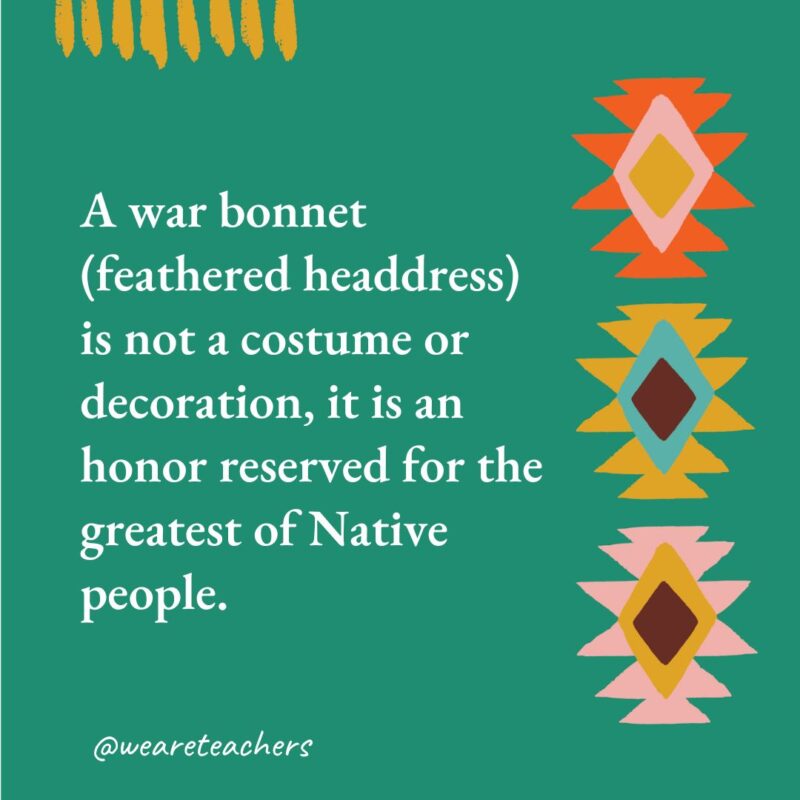
War bonnets are reserved for warriors who have completed a great number of deeds in life and battle. They are earned by a life of great deeds that your community acknowledges by gifting you the war bonnet. This may take a lifetime to achieve. Needless to say, if a Native community did not gift you a war bonnet, you shouldn’t be wearing one, nor wearing imitation war bonnets—both are disrespectful.
13. Not all Native Americans lived in teepees.

One of the most iconic symbols associated with Native Americans is the teepee. This is largely because of their depiction in Hollywood films, but also because of the lack of accurate Native American history taught in our school systems. The truth is Native housing/dwellings were just as diverse as our language and culture. Each geographic region supplied its own specific natural resources, which were utilized for dwellings. For example, the arctic tribes used igloos, the river tribes made mud homes, desert tribes used adobe, and the woodlands tribes built longhouses. These are but a few of the diverse variety of homes Natives lived in.
14. Yes, Native Americans have to pay taxes.

Federally recognized Indian tribal governments do not pay federal income tax but must pay employment taxes for their employees. However, individual members of these tribes must pay federal income and employment taxes, just like other U.S. citizens.
15. Alaska Natives prefer to be called “Inuit” for plural or “Inuk” for singular.

The word “Eskimo” is practically a racial slur and has nothing to do with arctic tribal culture.
16. The Inuit word “igloo” is not used strictly for a shelter made from snow and ice.

“Igloo” refers to any dwelling where someone lives. Therefore, the house you live in now is an “igloo.”
Hard-To-Face Native American Facts
17. Many tribes today are still not recognized by the U.S. government as sovereign nations.
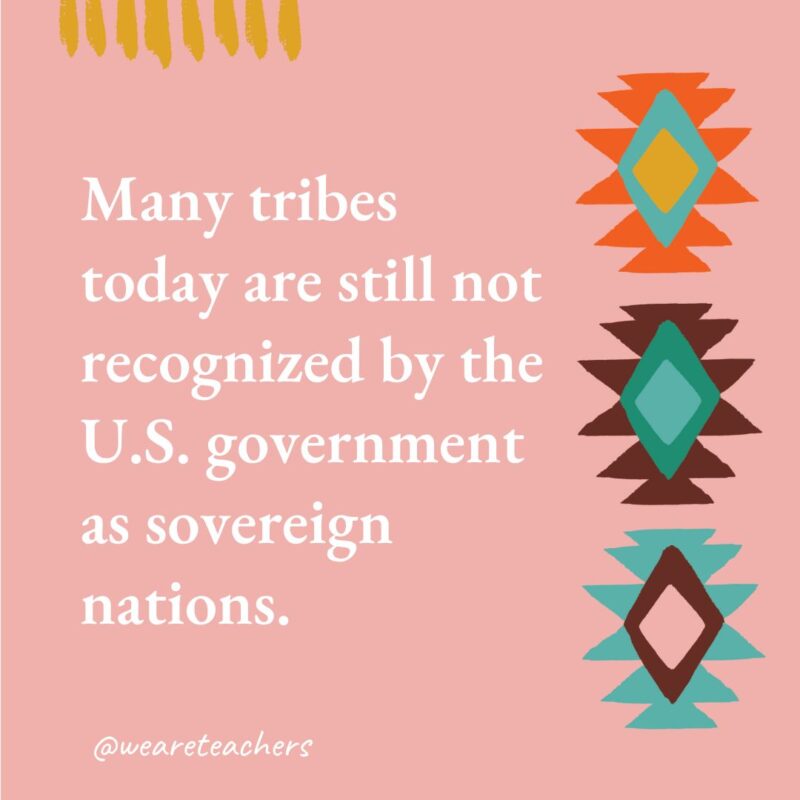
Some tribes, despite being the original inhabitants of this land, are still not recognized by the federal government. For example, the Ohlone of California are still fighting for federal recognition.
18. Hundreds of tribes still have no rights to their ancestral land.

Although there are over 500 federally recognized tribes in the United States, more than 200 of them are without land rights. This number doesn’t factor in the tribes that are still fighting for federal recognition.
19. More than 10,000 Native people died on the Trail of Tears.

In 1830, President Andrew Jackson signed the Indian Removal Act, which forcibly removed tribes from Alabama, Florida, Tennessee, and other states and sent them to Oklahoma. More than 10,000 Native people died during the forced journey.
20. U.S. and Canadian boarding schools stole Native children.

During the era of the boarding schools, Native children as young as 4 years of age were stolen from their families and placed in boarding schools. The U.S. policy was “kill the Indian, save the man.” Thousands upon thousands of Native children were systematically taught to forget their culture, their language, and their identity. They were abused physically and sexually, and many never made it home. Mass grave sites are being discovered around boarding schools in both the United States and Canada today, sparking the Every Child Matters movement.
21. It is estimated that from the year 1492 to 1900, more than 100 million Native Americans died prematurely as a result of the invasion of Europeans.

This is the result of colonialism that brought on, among other things, genocidal violence, disease, wars, forced relocation, and destruction of food sources. Since 1900, many Native people in the United States have died because of the lasting effects of colonialism and ongoing racism. It’s hard to know the exact number of Native deaths during much of the 20th century because there isn’t enough information available. However, it’s estimated that around 200,000 Native deaths may have happened due to these problems since 1900.
22. The buffalo were almost hunted to extinction in an attempt to subdue the Plains tribes.

Once upon a time, you could look over the Great Plains and spot a thunderous herd of buffalo roaming the tall grasslands. Their numbers were estimated to be more than 60 million. The U.S. military strategically wiped out the buffalo as a means to weaken the tribes that depended on the buffalo for their livelihood. The horrific campaign of slaughter worked, as the buffalo were nearly hunted to extinction.
Inspiring Native American Facts
23. A 22-year-old Tarahumara woman won an ultramarathon while wearing sandals and a skirt.
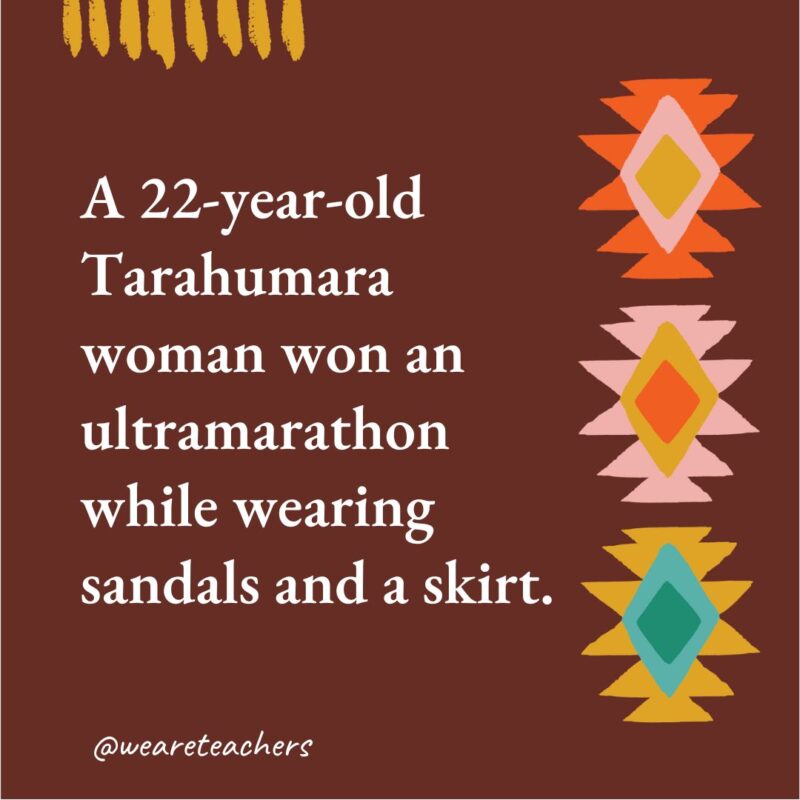
Maria Lorena Ramirez of the Tarahumara tribe beat 500 other competitors from 12 different countries in a 50-kilometer (31-mile) ultramarathon race … all while wearing her traditional clothing and Tarahumara-style sandals made from recycled tires.
24. It took more than 8,000 soldiers to capture the last band of free Apache.

It took roughly 5,000 U.S. Army personnel, plus 3,000 Mexican soldiers, and about 1,000 volunteers to bring them in for surrender.
25. Native dogsled mushers helped save Nome, Alaska, from a diphtheria outbreak.

During the 1925 diphtheria outbreak in Nome, harsh winter weather made it impossible for any plane or vehicle to make it to the villages to deliver the serum needed to fight the disease. However, a team of sled dog racers was put together to deliver the cure. Some of those mushers were Native Americans. This real event inspired the film “Balto.”
26. John Herrington was the first Native American to travel to space.

Herrington completed three space walks. He is an enrolled member of the Chickasaw Nation. He also brought along cultural artifacts and objects such as eagle feathers, sweetgrass, arrowheads, and wooden flutes on his journey through space!
27. Despite having his shoes stolen before the race, Native American Jim Thorpe went on to win two Olympic gold medals.

Olympian Jim Thorpe had already had a rough life with the loss of his twin brother at the age of 9 and the loss of both his parents shortly after, making him an orphan. And then somebody decided to steal Jim Thorpe’s shoes right before his Olympic race. Well, that didn’t stop Jim. He pulled two track shoes out of the trash … and they were from two different pairs of shoes. In fact, one of the shoes was so big, he had to put on extra socks to keep them on his feet. Did that stop Jim? Nope—Thorpe went on to win two gold medals!
28. Once forbidden in the United States, the Navajo Code Talkers’ language was used during WWII to help win the war.
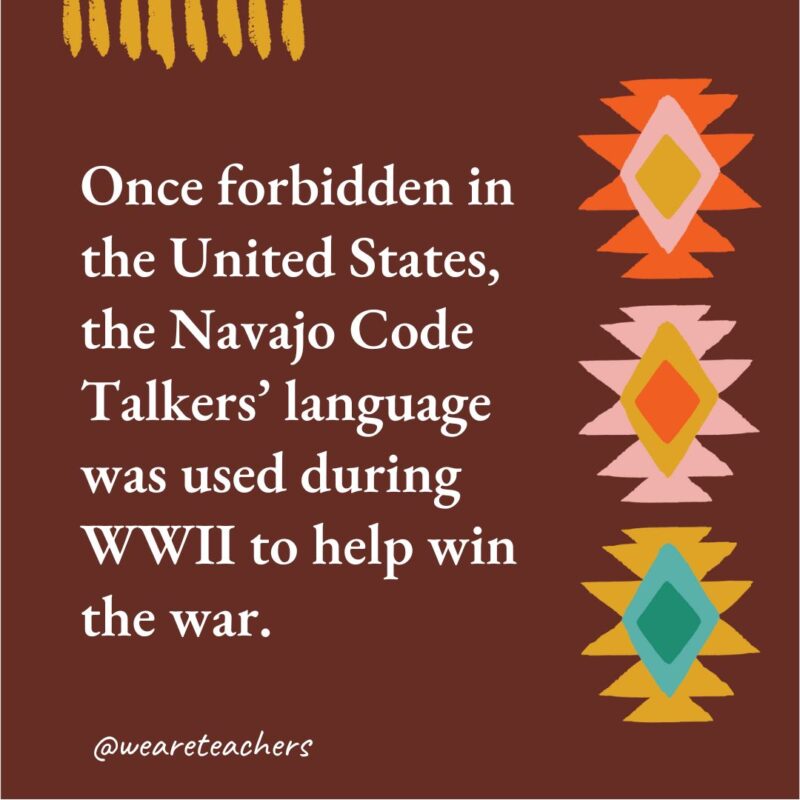
Their language was once forbidden by this country, but during World War II, the Navajo Code Talkers used their language to help win the war. Although the Japanese were able to crack many of the U.S. codes, the Navajo Code was never broken.
29. Lily Gladstone was the first Native American woman to win a Golden Globe for best actress.
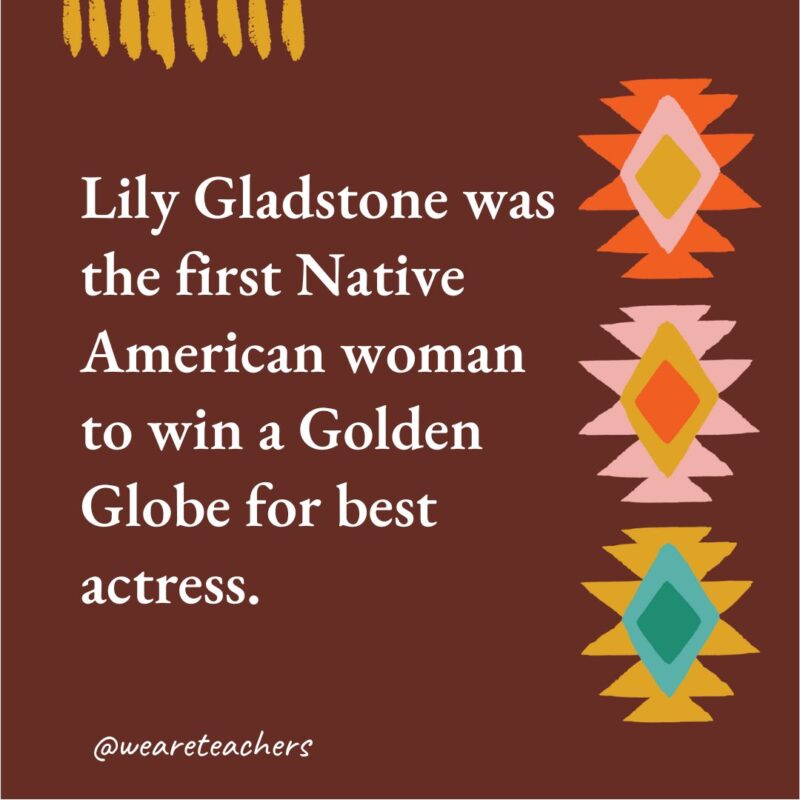
Lily Gladstone (Piegan Blackfeet and Nez Perce) was the first Native American woman to win a Golden Globe for best actress. This is not only a win for her and any Native child with a dream, but also a sign that Hollywood is trying to diversify the landscape of acting.
30. The Apache Sunrise Ceremony requires girls to fast, dance, and pray for four days as they transition into womanhood.

The Apache coming-of-age ceremony known as the Sunrise Ceremony is a special time to honor the transition of Apache girls into womanhood. The girls fast, run, and dance all night and day. Each girl’s family and community gather to encourage her through building, song, dance, and prayer. The ceremony itself lasts four days, but the whole process of building and breaking down camp can take weeks.
Get your Native American Facts slides!
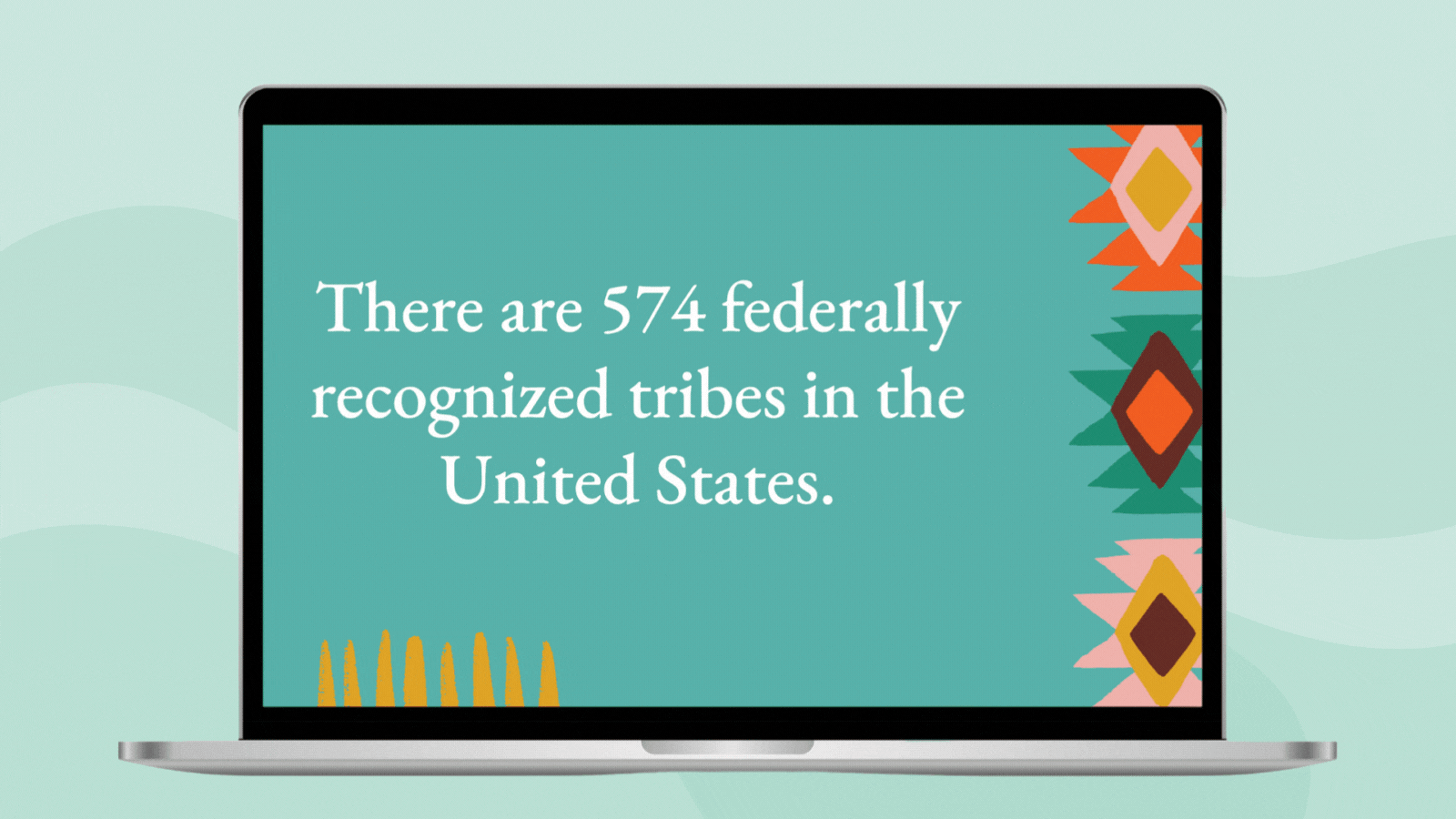
Click the button below to receive all the Native American facts above in a Google Slides format, giving you an easy way to share the facts with your students.






Leave a Reply